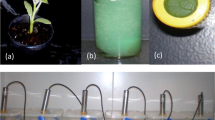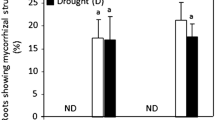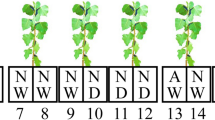Abstract
This study investigated the effects of atmospheric moisture on conidia development in cucurbit powdery mildew fungus (Podosphaera xanthii) through host-plant responses. Cucumber (Cucumis sativus L.) seedlings were grown under a high vapour pressure deficit (VPD) (3.8 kPa) or a low VPD (0.4 kPa). When the cotyledons had expanded, spores of P. xanthii were inoculated onto the adaxial surface. Inoculated seedlings for both treatments were then placed in a growth chamber maintained at a VPD of 2.1 kPa. The density of visible P. xanthii colonies on the high-VPD-acclimated cotyledons was 0.46 to 0.85 times that of the low-VPD-acclimated cotyledons 7 days after inoculation. It is likely the post-germination behaviour of P. xanthii such as the infection and consequent hyphal development was affected because spore germination did not differ between the treatments. The percentage of adaxial epidermal leaf cells with haustoria was also lower in the seedlings which had acclimated to a higher VPD. The high-VPD-acclimated cotyledons were thicker and had greater dry mass per area. The water potential of cotyledons did not differ between the treatments, although the stomatal conductance of high-VPD-acclimated cotyledons was lower than that of low-VPD-acclimated cotyledons. From these results, we conclude that the inhibition of P. xanthii conidia development on high-VPD-acclimated cotyledons was mainly caused by changes in leaf morphological properties.




Similar content being viewed by others
References
Aust, F., & v. Hoyningen-Huene, J. (1986). Microclimate in relation to epidemics of powdery mildew. Annual Review of Phytopathology, 24, 491–510.
Baker, E. A. (1974). The influence of environment on leaf wax development in Brassica oleracea var. gemmifera. New Phytologist, 73, 955–966.
Bandurska, H., & Stroiński, A. (2005). The effect of salicylic acid on barley response to water deficit. Acta Physiologiae Plantarum, 27, 379–386.
Bañon, S., Fernandez, J. A., Franco, J. A., Torrecillas, A., Alarcón, J. J., & Sánchez-Blanco, M. J. (2004). Effects of water stress and night temperature preconditioning on water relations and morphological and anatomical changes of Lotus creticus plants. Scientia Horticulturae, 101, 333–342.
Bañon, S., Ochoa, J., Franco, J. A., Alarcón, J. J., & Sánchez-Blanco, M. J. (2006). Hardening of oleander seedlings by deficit irrigation and low air humidity. Environmental and Experimental Botany, 56, 36–43.
Butt, D. J. (1978). Epidemiology of powdery mildews. In D. M. Spencer (Ed.), The powdery mildews (pp. 51–81). London: Academic.
Carroll, J. E., & Wilcox, W. F. (2003). Effects of humidity on the development of grapevine powdery mildew. Phytopathology, 93, 1137–1144.
Cook, R. T., Braun, U., & Beales, P. A. (2011). Development of appressoria on conidial germ tubes of Erysiphe species. Mycoscience, 52, 183–197.
Elad, Y., Messika, Y., Brand, M., Rav David, D., & Sztejnberg, A. (2007). Effect of microclimate on Leveillula taurica powdery mildew of sweet pepper. Phytopathology, 97, 813–824.
Farquhar, G. D. (1978). Feedforward responses of stomata to humidity. Australian Journal of Physiology, 5, 787–800.
Grantz, D. A. (1990). Plant response to atmospheric humidity. Plant, Cell & Environment, 13, 667–679.
Guzman-Plazola, R. A., Davis, R. M., & Marois, J. J. (2003). Effects of relative humidity and temperature on spore germination and development of tomato powdery mildew. Crop Protection, 22, 1157–1168.
Harris, J. G., & Manners, J. G. (1983). Influence of relative humidity on germination and disease development in Erysiphe graminis. Transactions of the British Mycological Society, 81, 605–611.
Hoad, S. P., Grace, J., & Jeffree, C. E. (1997). Humidity response of cuticular conductance of beech (Fagus sylvatica L.) leaf discs maintained at high relative water content. Journal of Experimental Botany, 48, 1969–1975.
Hull, H. M., Morton, H. L., & Wharrie, J. R. (1975). Environmental influences on cuticle development and resultant foliar penetration. The Botanical Review, 41, 421–452.
Jenks, A. M., Eigenbrode, D. S., & Lemieux, B. (2002). Cuticular waxes of Arabidopsis. In C. R. Somerville & E. M. Meyerowitz (Eds.), The Arabidopsis book. Rockville: American Society of Plant Biologists. doi:10.1199/tab.0016.
Kenyon, D. M., Dixon, G. R., & Helfer, S. (2002). Effects of relative humidity, light intensity and photoperiod on the colony development of Erysiphe sp. on Rhododendron. Plant Pathology, 51, 103–108.
Kerstiens, G. (1996). Signalling across the divide: a wider perspective of cuticular structure–function relationships. Trends in Plant Science, 1, 125–129.
Koch, K., Hartmann, K. D., Schreiber, L., Barthlott, W., & Neinhuis, C. (2006). Influences of air humidity during the cultivation of plants on wax chemical composition, morphology and leaf surface wettability. Environmental and Experimental Botany, 56, 1–9.
Kosma, K. D., Bourdenx, B., Bernard, A., Parsons, P. E., Lü, S., Joubès, J., et al. (2009). The impact of water deficiency on leaf cuticle lipids of Arabidopsis. Plant Physiology, 151, 1918–1929.
Lange, O. L., Lösch, R., Schulze, E. D., & Kappen, L. (1971). Responses of stomata to changes in humidity. Planta, 100, 76–86.
Lebeda, A., Sedlářová, M., Petřivalský, M., & Prokopová, J. (2008) Diversity of defence mechanisms in plant-oomycete interactions: a case study of Lactuca spp. and Bremia lactucae. European Journal of Plant Pathology 122, 71–89.
Mackovà, J., Vašková, M., Macek, P., Hronková, M., Schreiber, L., & Šantrůček, J. (2010). Plant response to drought stress simulated by ABA application: changes in chemical composition of cuticular waxes. Environmental and Experimental Botany, 86, 70–75.
Mortensen, L. M., & Gislerød, H. R. (2005). Effect of air humidity variation on powdery mildew and keeping quality of cut roses. Scientia Horticulturae, 104, 49–55.
Peak, D., & Mott, K. A. (2011). A new, vapour-phase mechanism for stomatal responses to humidity and temperature. Plant, Cell and Environment, 34, 162–178.
Quinn, J. A., & Powell, C. C., Jr. (1982). Effects of temperature, light, and relative humidity on powdery mildew of begonia. Phytopathology, 72, 480–484.
Reuveni, R., & Rotem, J. (1974). Effect of humidity on epidemiological patterns of the powdery mildew (Sphaerotheca fuliginea) on squash. Phytoparasitica, 2, 25–33.
Ristic, Z., & Jenks, M. A. (2002). Leaf cuticle and water loss in maize lines differing in dehydration avoidance. Journal of Plant Physiology, 159, 645–651.
Shibuya, T., Terakura, R., Kitaya, Y., & Kiyota, M. (2006). Effects of low relative humidity and illumination on leaf water status of cucumber seedlings and growth of harvested cuttings. HortScience, 41, 410–413.
Shibuya, T., Hirai, N., Sakamoto, Y., & Komuro, J. (2009). Effects of morphological characteristics of Cucumis sativus seedlings grown at different vapor pressure deficits on initial colonization of Bemisia tabaci (Hemiptera: Aleyrodidae). Economic Entomology, 102, 2265–2267.
Shibuya, T., Itagaki, K., Tojo, M., Endo, R., & Kitaya, Y. (2011). Fluorescent illumination with high red-to-far-red ratio improves resistance of cucumber seedlings to powdery mildew. HortScience, 46, 429–431.
Sitterly, W. R. (1978). Powdery mildew of cucurbits. In D. M. Spencer (Ed.), The powdery mildews (pp. 359–379). London: Academic.
Smith, E. F., Roberts, A. V., & Mottley, J. (1990). The preparation in vitro of chrysanthemum for transplantation to soil. Plant Cell, Tissue and Organ Culture, 21, 141–145.
Szwacka, M., Tykarska, T., Wisniewska, A., Kuras, M., Bilski, H., & Malepszy, S. (2009). Leaf morphology and anatomy of transgenic cucumber lines tolerant to downy mildew. Biologia Plantarum, 53, 697–701.
te Beest, D. E., Paveley, N. D., Shaw, M. W., & van den Bosch, F. (2008). Disease-weather relationships for powdery mildew and yellow rust on winter wheat. Phytopathology, 98, 609–617.
Thomas, P. A., Thomas, K., Mothi, P. K., & Senthil Maharajan, V. (1991). Use of lactophenol cotton blue mounts of corneal scrapings as an aid to the diagnosis of mycotic keratitis. Diagnostic Microbiology and Infectious Disease, 14, 219–224.
Torre, S., Fjeld, T., Gislerød, H. R., & Moe, R. (2003). Leaf anatomy and stomatal morphology of greenhouse roses grown at moderate or high air humidity. Journal of the American Society for Horticultural Science, 128, 598–602.
Tuba, Z., Lichtenthaler, H. K., Csintalan, Z., Nagy, Z., & Szente, K. (1996). Loss of chlorophylls, cessation of photosynthetic CO2 assimilation and respiration in the poikilochlorophyllous plant Xerophyta scabrida during desiccation. Physiologia Plantarum, 96, 383–388.
Walters, D., Walsh, D., Newton, A., & Lyon, G. (2005). Induced resistance for plant disease control: maximizing the efficacy of resistance elicitors. Phytopathology, 95, 1368–1373.
Whipps, J. M., & Budge, S. P. (2000). Effect of humidity on development of tomato powdery mildew (Oidium lycopersici) in the glasshouse. European Journal of Plant Pathology, 106, 395–397.
Yarwood, C. E. (1957). Powdery mildew. Botanical Review, 23, 235–301.
Zabka, V., Stangl, M., Bringmann, G., Vogg, G., Riederer, M., & Hildebrandt, U. (2007). Host surface properties affect prepenetration processes in the barley powdery mildew fungus. New Phytologist, 177, 251–263.
Acknowledgments
This research was supported by the Japan Society for the Promotion of Science (JSPS Grant-in-Aid for Scientific Research (B) (General), 24380140; Grant-in-Aid for JSPS Fellows, 2510391) and by the Osaka Prefecture University graduate school fellowship. We thank our reviewers and editors for their careful reading and valuable suggestions. We also thank Dr. Norio Hirai and MS. Lorien E. Radmer for their helpful suggestions.
Author information
Authors and Affiliations
Corresponding author
Additional information
Kaori Itagaki and Toshio Shibuya contributed equally to this work. Kaori Itagaki is a research fellow of Japan Society for the Promotion of Science.
Rights and permissions
About this article
Cite this article
Itagaki, K., Shibuya, T., Tojo, M. et al. Atmospheric moisture influences on conidia development in Podosphaera xanthii through host-plant morphological responses. Eur J Plant Pathol 138, 113–121 (2014). https://doi.org/10.1007/s10658-013-0309-1
Accepted:
Published:
Issue Date:
DOI: https://doi.org/10.1007/s10658-013-0309-1




